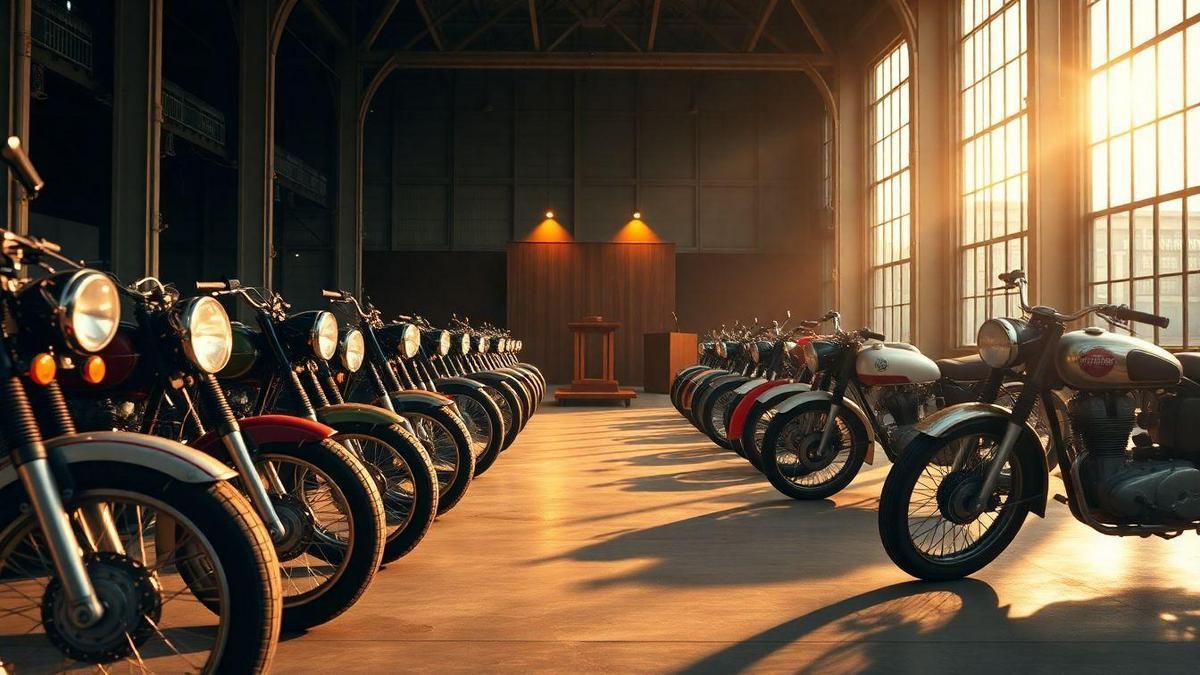Where to find motorcycle auction listings in the United States for your next buy
You want a clear place to start when you hunt for a bike at a motorcycle auction. Listings should show photos, title info, location, and fees. You also want options that match your goal: rare classic, project bike, or cheap runner.
The U.S. offers web-based platforms, salvage yards, specialty houses, and local live sales. Each channel has strengths. Use the right motorcycle auction channel and you save time, money, and disappointment.
This guide lists the main online platforms and live auction houses to watch, explains how to read listings and set filters, and shows how to inspect, bid, transport, and title a bike bought at auction.

Online motorcycle auction platforms: Bring a Trailer, eBay Motors, Mecum, and salvage sites
- Bring a Trailer (BaT): top for collector and classic motorcycles. Strong photo galleries, comment threads, full auction timelines, and documented histories make BaT ideal for well-documented bikes and active bidders.eBay Motors: huge range — daily drivers, projects, and some collectors. Use auction and Buy It Now; check completed sales for real prices. Expect mixed listing quality and request additional photos and title proof when needed.Mecum: major live events with strong online bidding. Mecum lists high-value, custom, and museum-quality lots; fees can be higher, but events draw serious buyers.Salvage platforms: Copart and IAAI list wrecks and titled parts machines — good for project searches at motorcycle auctions.
- Niche platforms: LiveAuctioneers, Proxibid, regional house sites, and Facebook Marketplace or Craigslist for private listings that sometimes lead to auction sales.
Keep a shortlist and check those motorcycle auction sites often.
Local and live motorcycle auction houses to watch
- National houses: Mecum, Bonhams, Barrett-Jackson, RM Sotheby’s (occasionally list motorcycles).Regional and local houses: Kruse, Auctions America, and independent estate or town auctioneers.
- Club and swap events: vintage clubs, rallies, and museum deaccessions can surface barn finds and well-documented sales.
Smaller houses may charge lower buyer fees and attract fewer collectors — that can mean bargains. Track regional calendars and subscribe to auction mailing lists.
How to read motorcycle auction listings and set filters to find what you want
Start with a simple ruleset: must-haves and deal-breakers.
Must-haves:
- Make, year range, running condition, and acceptable title type.
Deal-breakers:
- Salvage title (if you won’t accept it), missing frame numbers, or no photos.
Use filters for year, make, model, condition, title type, location, and price. Save searches and set alerts. Use keywords like matching numbers, barn find, project, and non-running.
When reading listings, confirm:
- VIN, title status, odometer, recent work, and clear photos.Photos should show both sides, engine and frame numbers, close-ups of wear, and damage.
- Sale type (reserve or no-reserve), buyer’s premium, applicable taxes, and pickup/shipping windows.
If photos or paperwork are missing, message the seller immediately. Take screenshots and save seller contact info. When possible, view the bike or hire a local inspector before bidding.
How to inspect vintage motorcycle auctions to verify authenticity
Authenticity changes value and restoration scope. Whether viewing in person or online, focus on numbers, paperwork, and parts.
Key steps:
- Bring a mechanic or hire a professional inspector if you lack experience.Decode the VIN with manufacturer guides or online decoders.Verify engine and frame numbers when matching numbers matter for the model.Request documentation: past registrations, maintenance receipts, auction invoices, and restoration records.
- Cross-check photos with past ads or auction listings (reverse image search can catch recycled images).
If anything smells staged or inconsistent, ask for more proof before you bid.
What to check: VIN, title history, and seller records
- Decode the VIN for year, plant, and engine type.Run history checks (Carfax for modern bikes; state DMV tools for liens and brands; Copart/IAAI for salvage info).Request chain-of-ownership paperwork: registrations, receipts, older photos, and prior auction results.Verify seller reputation: eBay feedback, BaT notes, or references from private sellers.
- Confirm the title’s brand (clean, salvage, rebuilt) and request lien releases if needed.
Spotting restorations vs. true barn finds
Restoration signs:
- Fresh paint with overspray, modern fasteners, or shiny new parts on an otherwise aged bike.
- Factory details replaced with non-period hardware, mismatched casting stamps, or inconsistent paint texture.
Barn find indicators:
- Dust in hard-to-reach places, original paper tags, consistent patina across leather, chrome and metal.
- Original wiring harness fabrics, aged fasteners, and even smell (old oil vs. solvent/paint odors).
Ask for start videos and specific numbered shots. For projects, request teardown footage showing internal parts.
Simple inspection checklist for on-site and online motorcycle auction viewings
- VIN: frame, engine, and title match.Title: note brand and liens.Photos: overall shots, engine numbers, frame plate, wheels, and damage points.Paint/body: look for masking, overspray, and texture.Patina: consistent wear across components.Wiring: cloth braid vs. modern replacement.Fasteners: matching aged bolts or recent replacements.Seals/gaskets: new seals on old engines may indicate recent work—ask for receipts.Start/compression: request a start video; note smoke or odd noises.Tires/rims: correct hub styles and stamped sizes.Documentation: registrations, receipts, old photos.Seller questions: ownership length, reason for sale, recent repairs.Transport notes: lot location, pickup window, crating options.
- Payment terms: deposit, methods, and schedule.
Bring a flashlight on site; online, insist on high-resolution photos and numbered shots.
How to prepare and bid at a motorcycle auction so you don’t overspend
Auction fever is real. Preparation prevents overpaying.
Three prep steps:
- Register and complete required paperwork early.Set a firm budget that includes fees and restoration costs.
- Choose a bidding strategy for the auction type.
Before the sale:
- Register with ID and payment info; note deposit requirements.Calculate total cost: hammer price buyer’s premium (typically 5–15%) sales tax shipping storage insurance restoration.
- Set your maximum bid and stick to it.
Bidding strategies for live and online motorcycle auction formats
- Online proxy bidding: set a top bid and let the system bid incrementally — good for avoiding emotional overbids.Live-stream auctions: snipe at the close or bid in the final seconds if you’re confident.Floor auctions: be patient; don’t react to every jump. Use clear gestures and a steady presence.Absentee bids: leave a maximum with the house if you can’t attend.
- Opening bids: a firm opening can deter casual bidders; waiting can let you gauge interest.
Always work from market value and restoration estimates — not emotion.
After you win a lot at a motorcycle auction: payment and pickup
Immediately after winning:
- Review the invoice for hammer price, buyer’s premium, sales tax, storage, and handling fees.Confirm accepted payment methods (wires, cashier’s checks, credit cards) and payment deadlines.Obtain signed title and bill of sale; some states require notarization.Arrange pickup or shipping promptly; storage fees accrue quickly.Document condition at handover with photos for disputes or insurance.
- Buy transit insurance for the move and keep receipts for tax and resale records.
How to find rare classic bikes and cheap vintage motorcycles at auctions
Rare bikes tend to appear at specialist auctions and collector houses; cheap projects are more likely at small local sales, salvage lots, and estate auctions. To find bargains:
- Scan many channels and compare realized prices.Buy off-peak or when provenance is unclear.Use keywords like project, parts, non-running, and barn find.Monitor local estate sales and small-town auctions where bikes may slip through.
- Join forums and clubs to receive leads before a bike reaches public motorcycle auction listings.
Comparing prices across vintage motorcycle auctions to find bargains
- Use realized sale prices from BaT, Mecum, and eBay completed listings to build price ranges.Always add buyer’s premium and likely taxes when comparing.Factor in shipping and registration across states.Consult valuation guides (Hagerty, NADA) and recent auction results.
- Keep a simple spreadsheet for model, year, condition, hammer price, fees, taxes, and shipping.
Evaluating rarity, provenance, and resale value before you bid
- Rarity includes surviving examples, correct factory options, and documented history.Provenance (ownership and service records, race wins) adds value.Matching engine and frame numbers usually command premiums; some models commonly had swaps.Consider whether an unrestored original is worth more than a poor restoration.Estimate resale by subtracting premiums, shipping, restoration, and holding costs from expected market value.
- If uncertain, wait — patience often finds better deals at future motorcycle auctions.
How to handle shipping, pickup, and title transfer after a U.S. motorcycle auction purchase
Moving the bike and paperwork across states requires planning. Choose the right carrier, insure the move, and follow DMV rules for title transfer.
Transport and insured shipping options across the United States
- Local pickup on a trailer when possible.Motorcycle shippers: open transport (cheaper) or enclosed transport (more protection).Flatbeds and crating for high-value bikes; specialist shippers use proper tie-downs.Verify carriers’ liability limits and consider third-party transit insurance.Salvage/non-running bikes: confirm carriers accept these and whether extra handling fees apply.
- Get multiple quotes and schedule pickup quickly to avoid storage penalties.
Title transfer, taxes, and state registration steps
- Seller should sign the title; some states require notarization.Check for liens and insist on written lien releases before final payment.Sales tax is usually paid at registration; keep the bill of sale for DMV proof.Rebuilt/salvage titles often require inspection for a rebuilt title — process varies by state.Use temporary tags when allowed to move the bike legally.
- If the seller lacks a clear title, don’t pay in full until the title is secured.
Post-auction timeline and checklist to get your new collector motorcycle home
- Within 24 hours: pay the deposit, confirm payment method, and get the invoice.Within 48 hours: arrange carrier or pickup and buy transit insurance.Within 5 days: make full payment and collect signed title and bill of sale.Within 7 days: inspect the delivered bike and document condition.
- Within 30 days: file registration and title transfer with your DMV and pay taxes/fees.
Keep all receipts, shipping documents, and correspondence.
How to protect yourself from legal risks, salvage titles, and big restoration costs at motorcycle auctions
Auctions carry hidden risks: title brands, liens, and costly restorations. Protect yourself with checks and conservative decisions.
Recognizing salvage or branded titles and what that means
- Brands include salvage, rebuilt, flood, lemon law, and odometer.Salvage reduces resale value and complicates insurance and registration.Rebuilt titles with inspection reports and receipts are preferable to unproven salvage titles.
- Confirm insurance options for a branded bike before you bid.
Estimating restoration costs and parts needs
- Itemize work: engine, transmission, electrical, paint, chrome, tires, upholstery.Get local shop quotes; top-end jobs can cost hundreds, full rebuilds thousands.Parts availability drives cost: common models are cheaper; rare bikes need NOS or fabrication.Labor quality matters — specialists cost more but reduce risk.
- Get at least two quotes before you buy. If restoration blows the budget, walk away.
Legal checks, insurance choices, and pre-bid warranties
- Verify VIN/title at the DMV and check for liens.Request a signed bill of sale that lists VIN, sale price, buyer and seller names, and date.Discuss coverage with insurers: agreed-value policies, transit insurance, and restoration coverage.Read auction T&Cs for as is clauses, arbitration, and dispute rules.Consider a third-party pre-bid inspection or mechanic’s report.
- For imports, check customs and EPA restrictions before bidding.
If legal or title issues feel messy, don’t bid — the auction market has many bikes.
Motorcycle auction quick tips (summary)
- Pick the right channel for the bike you want: collector auctions for documented bikes, salvage platforms for projects, local houses for bargains.Use saved searches and keyword filters (project, barn find, matching numbers) to find relevant motorcycle auction listings.Always include buyer’s premium, taxes, shipping, insurance, and restoration in your budget.Verify VIN, title brand, and seller documentation before bidding.Hire an inspector for expensive or high-risk purchases.Arrange transport and transit insurance immediately after the sale.
- Keep all paperwork for registration, insurance, and resale.
Buying at a motorcycle auction can net rare finds and great deals — but success depends on preparation, clear filters, careful inspection, and strict budgeting. Follow these steps to reduce risk and ride away with the right bike at the right price.

